School Robotics Competition in Illinois, USA
Recently, I participated as a judge in a robotics competition among high school students at the Batavia secondary school (Rotolo Middle School, Batavia), Illinois, USA. I would like to tell about these competitions - the guys who participated in them, as well as their robots impressed me.
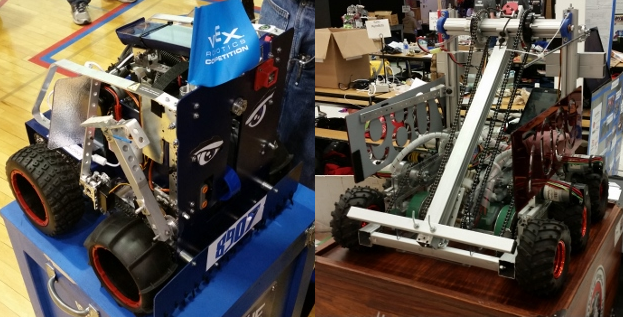
In fact, quite by accident. I do particle physics on the NOvA experiment at Fermilab - this is a national accelerator laboratory in Illinois, near Chicago. The school in which the competitions were held is close to the laboratory, and these competitions have been held there for more than a year, and several people from Fermilab are not the first time participating in them as judges. They needed volunteers, and they called my friends, and they already called me.
')
In professional life, I am engaged in software development and science, but I have never been engaged in robots. But refereeing required, rather, common sense and the ability to correctly ask questions than special knowledge. How exactly the competitions were held and the robots were evaluated, I will tell below - this is quite interesting.
The competition in which I was a judge - FIRST® Tech Challenge (FTC) - one of the line of competitions in robotics FIRST® . Also in the lineup is the FIRST® Robotics Competition for approximately the same age category, as well as the FIRST® LEGO® League for younger students. Schoolchildren of grades 7-12 (12-18 years old) participate in the FTC. FTC is quite a popular competition, teams from about 40 countries participate in the world. In Russia, the FTC will be held February 20-21 in Sochi .
The basis of the competition is the game of robots. Games change every year, this time it was a RES-Q game, in which 4 robots (in teams of 2) must move across the field and collect cubes and balls at certain points in the field, press buttons, move figures of little men into baskets, climb on ramp and push the levers on the sides of the ramp. Two opposing teams can not intentionally interfere with each other, block the passage and so on (for more information about the rules, you can see, for example, here ).
The field for the game with ramps, balls and robots located looks like this:
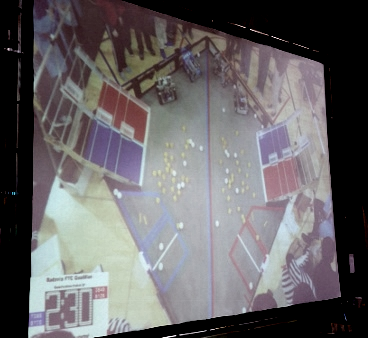
The rules of the game are not very balanced - but I do not want to write spoilers, since in Russia the competition has not yet passed. I think the rules could be more balanced if they were preserved with small changes every year, but on the other hand, the robots would become too specialized.
In total there were 2 lines of awards - awards awarded by judges in different nominations (for judicial nominations, the effectiveness of the robot during the games mattered, but not only it - about this below), and separate awards for the winners of the games. The main nomination from judges is made in the category Inspire - the best team in terms of technical training, quality of a robot, quality of a technical report, etc. There are also categories of Think, Innovate and several others - here prizes are given for the best engineering solutions, original ideas and so on.
An interesting feature of the judging here is that not only the technical characteristics of the robot and the technical knowledge of the team are assessed. It would be interesting to watch the Russian competitions, since here in Russia, as I see it, the emphasis is traditionally placed on the technical part.
In addition to the technical part, the social involvement of the teams was also evaluated here - many teams, for example, organized workshops and demonstrations in schools, museums, etc ... Some of this activity was organized by the teams themselves, and some were organized by the FTC. To identify the best in social activity, there was a separate nomination “Connect”, which, by the way, was won by a team sponsored by a local pizzeria - they attracted many schoolchildren to their events at the expense of free pizza.
Another interesting (and very American) feature is that the teams themselves are looking for sponsors. They do not earn money on this, but it gives them the opportunity to buy details, make shirts with logos,bribe judges and so on, and also adds motivation. Sponsoring was very different - someone had no private sponsors, the school allocated money to them, many were sponsored from small private sources (I think, first of all parents), someone from private companies, such as that pizzeria, someone then from large corporations - one of the teams, for example, was sponsored by Motorola, and another one - by Microsoft. The average amount of funds raised was about $ 1,000 per season, the record was for the Fruit Salad team - about $ 8,000, and the same team eventually received a prize in the main nomination.
In addition, teams often have their website and Facebook page. For example, such commands: GotRobot , Octopi , Fruit Salad , etc. In short, for teams in addition to competition, it is still something like organizing and promoting a small business.
Here are the teams and their robots:
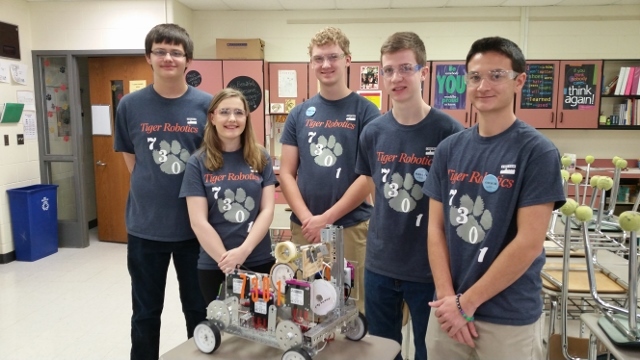

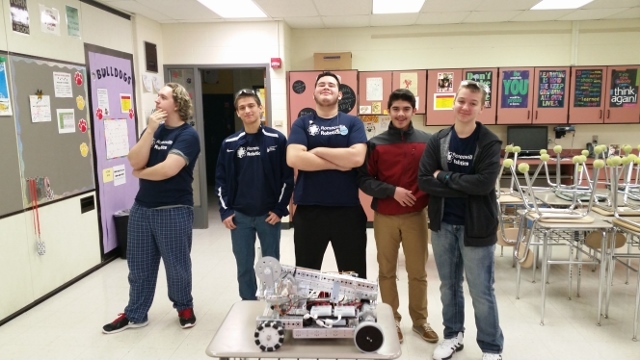

And this is how the games themselves (in the blue robes there are judges, and in striped T-shirts - the referee):
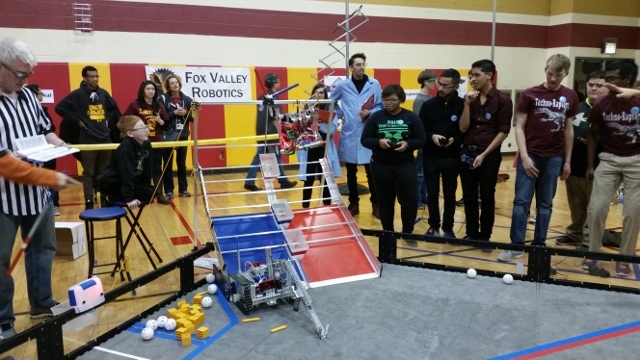
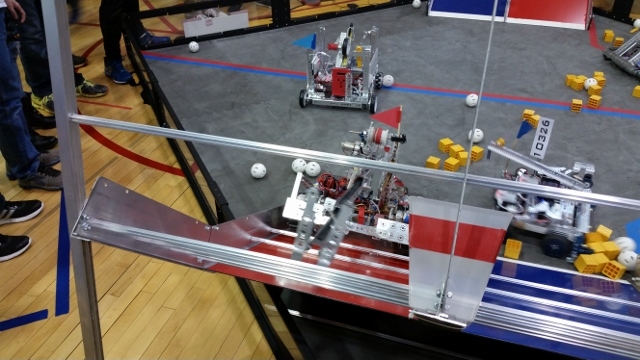
The preparation of teams and the quality of the technical report were very different for different teams. The technical documents of many teams were leaflets with brief reports on their weekly progress, of which nothing was clear, but the best reports were a miracle of technical documentation, especially for schoolchildren. One of the highest-quality reports was in the very winning team of Fruit Salad - there were reports on events held, financial reports on funds raised, illustrations in AutoCAD, code samples, illustrations of using kanban boards, etc. Unfortunately, I have never found their technical documents in the public domain - apparently, they are keeping technical secrets from other teams.
It is also interesting that many teams ordered 3D printing of some elements of their robot - usually these were not very significant details, for example, a holder for a phone or a box for placing wires, but there was a team that used, for example, 3D printing to create wheels of a robot.
The main part of the allowed parts for the competition is the TETRIX robotics kit for mechanical parts and servo drives, drive and power distribution controllers and an Android phone as the main platform for programs, as well as a second phone that receives signals from gamepads and sends them to the first one. Programming is allowed only on java in Android Studio or App Inventor.

Some technologies that seem logical for such robots, for example, Raspberry Pi, are prohibited for use. As far as I know, technical rules can change quickly enough, so that, perhaps, they will sometime be allowed.
Some functions of the robots were automated, for example, the teams used color sensors to press the correct button, but most of the functions were controlled through gamepads, and usually each robot had two drivers - one responsible for the movement, the second for the mechanisms that allow them to collect cubes or climb the hill .
American schools now promote STEM (science, technology, engineering, mathematics). This keyword was on the VEX and FTC websites, and was also constantly used during the competition - when presenting awards, as well as in the opening remarks of local officials.
In my experience, from this set of science and mathematics is still much stronger in our schools and universities - until it reaches the very scientific work, with which we have bad. Here, school and university education in the natural sciences and mathematics is, on average, weak enough, and in order to change it, it is necessary to grow strong scientific schools.
With regard to technology and engineering - I can only judge by small manifestations, such as, for example, this competition. But it seems to me that here these areas are better developed, and the groundwork is being made for a large margin. For example, this is evidenced by the popularity of robotics. In Illinois, according to last year's data, 110-120 teams participated in these robots competitions with 13 million inhabitants ( taken from here ). For comparison, at similar competitions in Russia, FTC Russia Open, which I have already mentioned, 25 teams are registered.
I think it’s better to take this difference not as a reason to be upset, but as a field for opportunities. The most necessary thing for this is initiative and motivation, which is needed more than technical training and even money. For example, among the teams at this competition was a team sponsored only from the school and had no adult mentors, except for one person who helped them from time to time.
I'm not sure that the American experience can be transferred directly to our soil, although it would be an interesting experiment. For example, as I already said, we traditionally pay more attention to the technical side, rather than the organizational one (funny fact: all foreign FTC sites focus on sports and educational events, and I could not find the technical specifications of robots there, on the Russian FTC site it was The first thing that the eye fell on). Therefore, in order to build funding for a local business team, it is necessary to break some stereotypes. On the other hand, I do not think that this is so impossible - from my experience in dealing with people from business, a business of any size is more socially responsible than officials, and may well donate a certain amount of money, especially since in the end the team will use them symbolism.

How did I get to the competition
In fact, quite by accident. I do particle physics on the NOvA experiment at Fermilab - this is a national accelerator laboratory in Illinois, near Chicago. The school in which the competitions were held is close to the laboratory, and these competitions have been held there for more than a year, and several people from Fermilab are not the first time participating in them as judges. They needed volunteers, and they called my friends, and they already called me.
')
In professional life, I am engaged in software development and science, but I have never been engaged in robots. But refereeing required, rather, common sense and the ability to correctly ask questions than special knowledge. How exactly the competitions were held and the robots were evaluated, I will tell below - this is quite interesting.
About competitions
The competition in which I was a judge - FIRST® Tech Challenge (FTC) - one of the line of competitions in robotics FIRST® . Also in the lineup is the FIRST® Robotics Competition for approximately the same age category, as well as the FIRST® LEGO® League for younger students. Schoolchildren of grades 7-12 (12-18 years old) participate in the FTC. FTC is quite a popular competition, teams from about 40 countries participate in the world. In Russia, the FTC will be held February 20-21 in Sochi .
How are the competitions?
The basis of the competition is the game of robots. Games change every year, this time it was a RES-Q game, in which 4 robots (in teams of 2) must move across the field and collect cubes and balls at certain points in the field, press buttons, move figures of little men into baskets, climb on ramp and push the levers on the sides of the ramp. Two opposing teams can not intentionally interfere with each other, block the passage and so on (for more information about the rules, you can see, for example, here ).
The field for the game with ramps, balls and robots located looks like this:

The rules of the game are not very balanced - but I do not want to write spoilers, since in Russia the competition has not yet passed. I think the rules could be more balanced if they were preserved with small changes every year, but on the other hand, the robots would become too specialized.
In total there were 2 lines of awards - awards awarded by judges in different nominations (for judicial nominations, the effectiveness of the robot during the games mattered, but not only it - about this below), and separate awards for the winners of the games. The main nomination from judges is made in the category Inspire - the best team in terms of technical training, quality of a robot, quality of a technical report, etc. There are also categories of Think, Innovate and several others - here prizes are given for the best engineering solutions, original ideas and so on.
How are teams evaluated
An interesting feature of the judging here is that not only the technical characteristics of the robot and the technical knowledge of the team are assessed. It would be interesting to watch the Russian competitions, since here in Russia, as I see it, the emphasis is traditionally placed on the technical part.
In addition to the technical part, the social involvement of the teams was also evaluated here - many teams, for example, organized workshops and demonstrations in schools, museums, etc ... Some of this activity was organized by the teams themselves, and some were organized by the FTC. To identify the best in social activity, there was a separate nomination “Connect”, which, by the way, was won by a team sponsored by a local pizzeria - they attracted many schoolchildren to their events at the expense of free pizza.
Another interesting (and very American) feature is that the teams themselves are looking for sponsors. They do not earn money on this, but it gives them the opportunity to buy details, make shirts with logos,
In addition, teams often have their website and Facebook page. For example, such commands: GotRobot , Octopi , Fruit Salad , etc. In short, for teams in addition to competition, it is still something like organizing and promoting a small business.
Here are the teams and their robots:




And this is how the games themselves (in the blue robes there are judges, and in striped T-shirts - the referee):


The preparation of teams and the quality of the technical report were very different for different teams. The technical documents of many teams were leaflets with brief reports on their weekly progress, of which nothing was clear, but the best reports were a miracle of technical documentation, especially for schoolchildren. One of the highest-quality reports was in the very winning team of Fruit Salad - there were reports on events held, financial reports on funds raised, illustrations in AutoCAD, code samples, illustrations of using kanban boards, etc. Unfortunately, I have never found their technical documents in the public domain - apparently, they are keeping technical secrets from other teams.
It is also interesting that many teams ordered 3D printing of some elements of their robot - usually these were not very significant details, for example, a holder for a phone or a box for placing wires, but there was a team that used, for example, 3D printing to create wheels of a robot.
Some technical details
The main part of the allowed parts for the competition is the TETRIX robotics kit for mechanical parts and servo drives, drive and power distribution controllers and an Android phone as the main platform for programs, as well as a second phone that receives signals from gamepads and sends them to the first one. Programming is allowed only on java in Android Studio or App Inventor.

Some technologies that seem logical for such robots, for example, Raspberry Pi, are prohibited for use. As far as I know, technical rules can change quickly enough, so that, perhaps, they will sometime be allowed.
Some functions of the robots were automated, for example, the teams used color sensors to press the correct button, but most of the functions were controlled through gamepads, and usually each robot had two drivers - one responsible for the movement, the second for the mechanisms that allow them to collect cubes or climb the hill .
And a little philosophy
American schools now promote STEM (science, technology, engineering, mathematics). This keyword was on the VEX and FTC websites, and was also constantly used during the competition - when presenting awards, as well as in the opening remarks of local officials.
In my experience, from this set of science and mathematics is still much stronger in our schools and universities - until it reaches the very scientific work, with which we have bad. Here, school and university education in the natural sciences and mathematics is, on average, weak enough, and in order to change it, it is necessary to grow strong scientific schools.
With regard to technology and engineering - I can only judge by small manifestations, such as, for example, this competition. But it seems to me that here these areas are better developed, and the groundwork is being made for a large margin. For example, this is evidenced by the popularity of robotics. In Illinois, according to last year's data, 110-120 teams participated in these robots competitions with 13 million inhabitants ( taken from here ). For comparison, at similar competitions in Russia, FTC Russia Open, which I have already mentioned, 25 teams are registered.
I think it’s better to take this difference not as a reason to be upset, but as a field for opportunities. The most necessary thing for this is initiative and motivation, which is needed more than technical training and even money. For example, among the teams at this competition was a team sponsored only from the school and had no adult mentors, except for one person who helped them from time to time.
I'm not sure that the American experience can be transferred directly to our soil, although it would be an interesting experiment. For example, as I already said, we traditionally pay more attention to the technical side, rather than the organizational one (funny fact: all foreign FTC sites focus on sports and educational events, and I could not find the technical specifications of robots there, on the Russian FTC site it was The first thing that the eye fell on). Therefore, in order to build funding for a local business team, it is necessary to break some stereotypes. On the other hand, I do not think that this is so impossible - from my experience in dealing with people from business, a business of any size is more socially responsible than officials, and may well donate a certain amount of money, especially since in the end the team will use them symbolism.
Source: https://habr.com/ru/post/390451/
All Articles